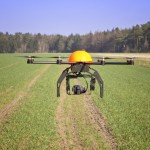 I have written an increasing amount about the various innovative ways in which drones are being deployed around the world. For instance, they are being used by Microsoft to detect the onset of disease, whilst Johns Hopkins researchers are using them to transport blood samples and SwissPost to deliver the mail.
I have written an increasing amount about the various innovative ways in which drones are being deployed around the world. For instance, they are being used by Microsoft to detect the onset of disease, whilst Johns Hopkins researchers are using them to transport blood samples and SwissPost to deliver the mail.
They might soon becoming to a farm near you, at least according to researchers at Texas A&M university.
“One day, flying a UAV will be a routine task an agricultural producer performs on a regular basis to help him efficiently maintain his crops, improve yields and optimize resources, especially water,” they say.
Farming drones
Sensors are being tested that will monitor the farmers land to help the farmer make better decisions about what to grow, when to grow it, and where to grow it. It will inform them about things such as irrigation and fertilization.
Initial research has been conducted that highlights the promise of such advanced sensor technology, with initial results showing the benefits in terms of water detection, insect stresses and so on.
It also allows the farmer to make rapid decisions about individual plants, thus allowing a reduced timeframe for selecting the best crop for their land.
“The amount of time spent evaluating individual plants would be drastically reduced, which would greatly accelerate the time it takes to develop improved varieties,” the researchers say.
Sense and respond
The sensors being used typically include ultrasound devices to measure plant height, infrared thermometers to measure the temperature of the soil and of plants, and also hyperspectral sensors to measure the water content of leaves. They are also considering sensors to detect the normalized difference vegetation index (or photosynthesis rate to you and me).
The hope is that after this initial testing phase, we will have a much better idea of what kind of sensors are needed and how they can be made sufficiently light to be carried on a drone. Once this technical feasibility has been established, the numbers will be crunched to test their economic feasibility.
Eventually, it’s hoped that the data collected by the drones would be available to farmers on their mobile devices, much as the modern factory provides all manner of diagnostic data via them.
“That farmer could then compare what he’s seeing in the field with what the application is telling him to do,” the researchers say. “The idea is to make the decision-making process easier for the farmer while optimizing his resources to get better yields and increase profitability.”
You can find out more about the project via the video below.
Nice video on using drones on the farm here, courtesy of IBM
https://www.youtube.com/watch?feature=player_embe…
Great find, thanks for that Wayne.
Nice project, looks really useful.